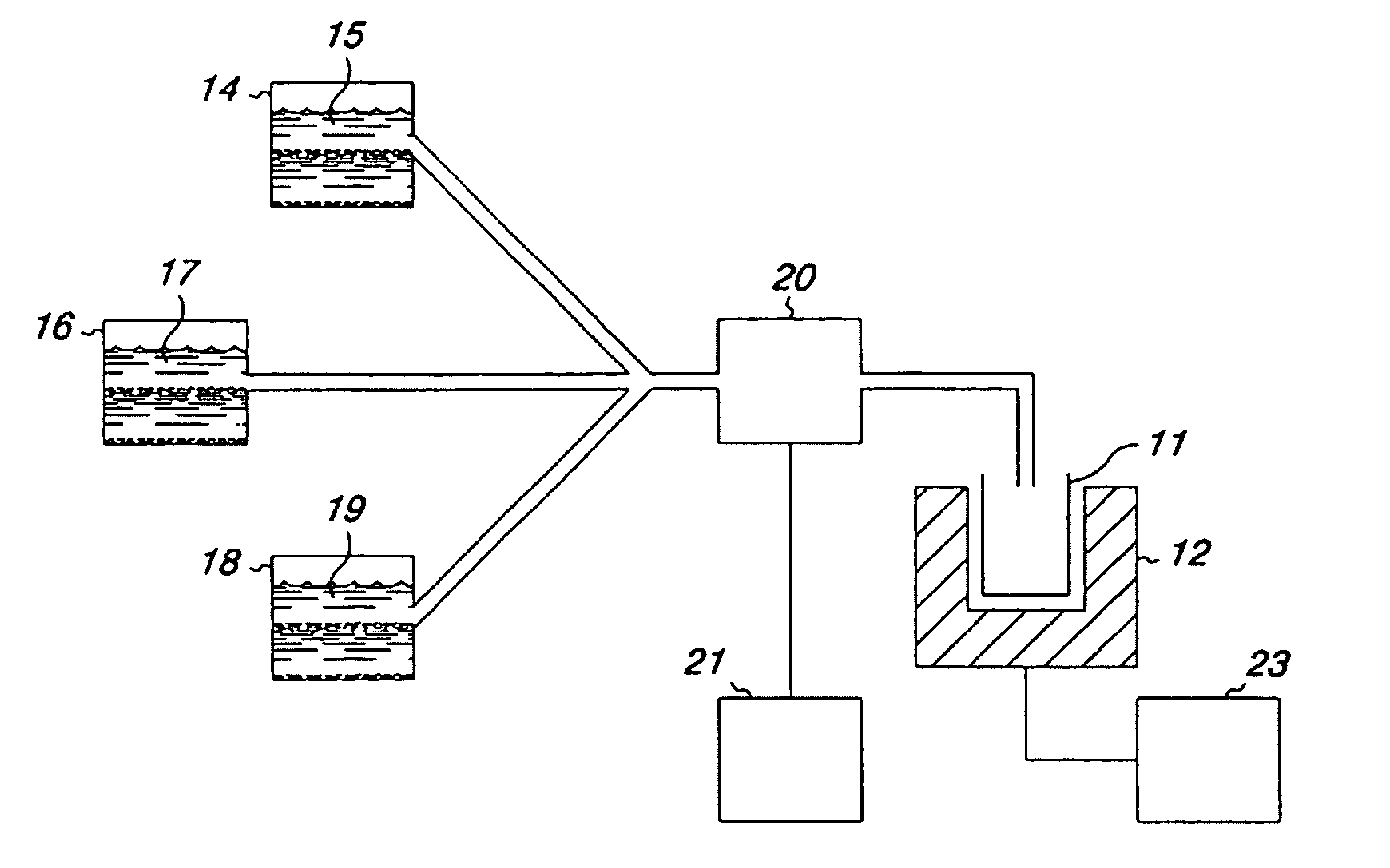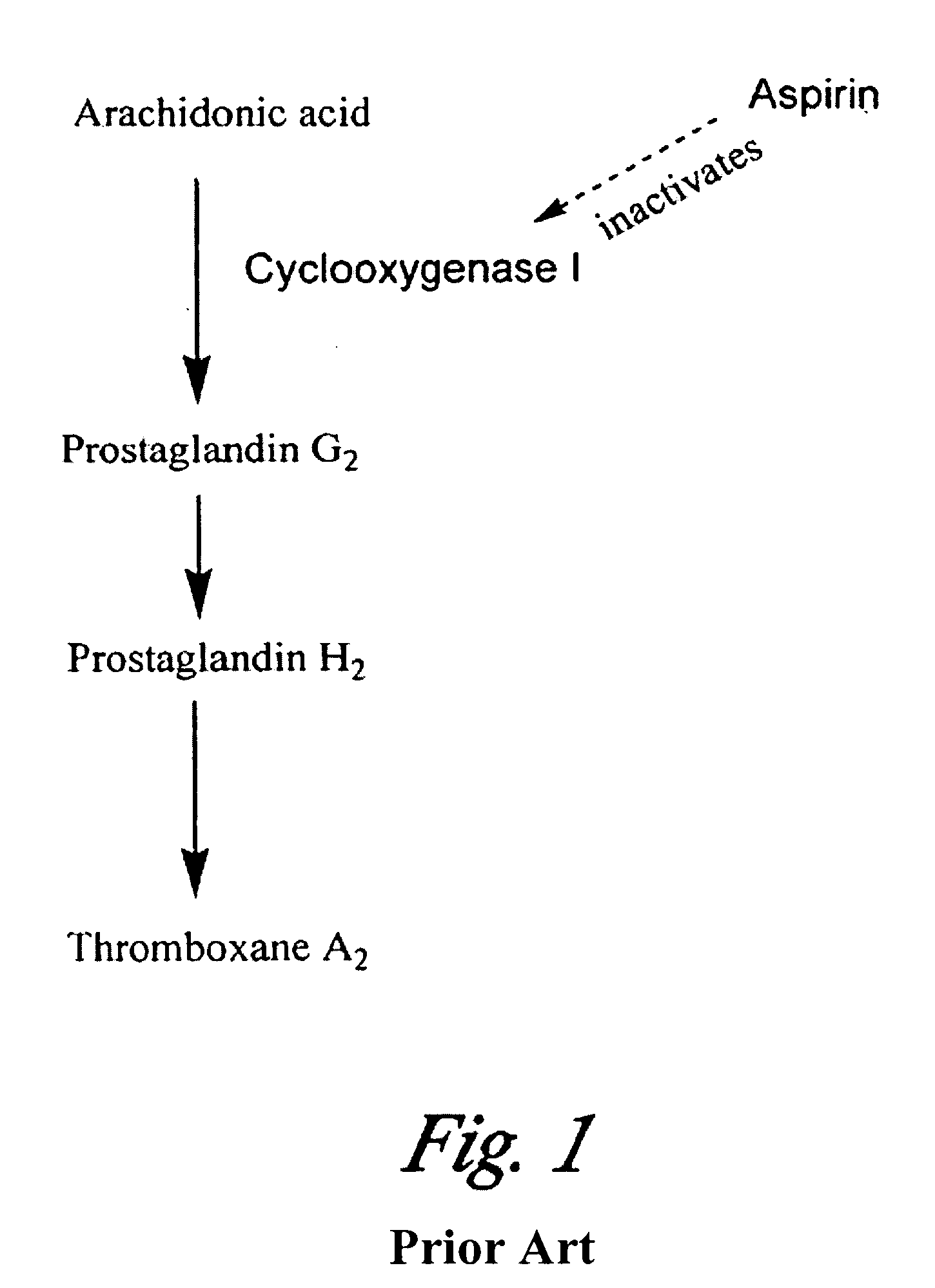Method and device for monitoring inhibition of platelet function
a platelet function and monitoring device technology, applied in the field of physiological analysis, can solve the problems of pulmonary embolism, stroke-related conditions, pulmonary embolism, and people at risk of pathological cardiovascular events, and achieve the effects of shortening the duration of action, increasing light emissivity, and large reduction of light emission
- Summary
- Abstract
- Description
- Claims
- Application Information
AI Technical Summary
Benefits of technology
Problems solved by technology
Method used
Image
Examples
example 1
Assaying Platelet Aspirin Response.
Methods:
[0085]Volunteers who had not taken aspirin in the previous 24 hours underwent a finger prick to draw blood. Blood (2.mu.l) was diluted into 1 ml of buffer (PBS, 0.9% NaCl, 10 mM sodium phosphate, pH 7.0) in a clear test tube. An aliquot (15 .mu.l) of luciferin / luciferase solution (containing 10 mg / ml luciferin and 10 .mu.g / ml luciferase) as added to the diluted blood. The solution was mixed and placed in a Zylux FEMPTOMASTER FB12 photon counter. A baseline reading of the light emission was taken. The test tube was then withdrawn, and 5 .mu.l of 15 mM arachidonic acid was added to the solution and the solution was mixed. The test tube was then reinserted in the photon counter and light emission readings were taken for approximately 2 to 4 minutes.
[0086]The volunteer then swallowed or chewed an aspirin (325 mg). A blood sample was taken, and the process was repeated. The results from blood drawn from an individual before and after taking aspi...
example 2
[0091]An Apparatus for Monitoring Aspirin Response that Pumps Fluids into a Cuvette
[0092]The apparatus is shown in FIG. 6. Blood is diluted and stored in a diluted blood chamber or container 14. Firefly luciferin and luciferase are stored in a firefly extract container 16. Arachidonic acid is stored in a third container, an arachidonic acid container 18. Tubing 23 connects the solutions in each container to a bi-directional pump 20. The tubing to the three containers merges together before the pump, so that fluid is pumped by the pump simultaneously from all three containers and mixed together. If the tubing to each container is the same diameter, equal volumes are pumped from each container. By using tubing of unequal diameters to each container, the volume drawn from each container relative to the others can be controlled. The drawn fluids come together in the merged section of the tubing and are pulled by the pump 20 past a check valve 13. After the check valve the fluids are pum...
example 3
Fluid Injection Analysis and Sequential Injection Analysis
[0094]A typical fluid injection analysis (FIA) manifold includes a pump, injection valve, photon counter, and tubing. The pump is used to propel one or more streams through the photon counter via a narrow-bore (0.5-0.8 mm ID) tubing. These streams may be reagents or buffer. The injection valve is used to periodically introduce a small volume (generally less than 100 .mu.1) sample of one reagent into the carrier stream. As the sample is carried to the detector, the fluid dynamics of flow through a narrow-bore tubing mixes sample and carrier, leading to the reaction to form a detectable species (in this case light emission). This species is sensed by the detector as a transient peak. The height and area of the peak are proportional to concentration and are used to quantify the concentration of the species being determined by comparison to samples of known concentration (a calibration curve). Thus, for instance, blood, dilution ...
PUM
| Property | Measurement | Unit |
|---|---|---|
| volume | aaaaa | aaaaa |
| diameter | aaaaa | aaaaa |
| volume | aaaaa | aaaaa |
Abstract
Description
Claims
Application Information
 Login to View More
Login to View More - R&D
- Intellectual Property
- Life Sciences
- Materials
- Tech Scout
- Unparalleled Data Quality
- Higher Quality Content
- 60% Fewer Hallucinations
Browse by: Latest US Patents, China's latest patents, Technical Efficacy Thesaurus, Application Domain, Technology Topic, Popular Technical Reports.
© 2025 PatSnap. All rights reserved.Legal|Privacy policy|Modern Slavery Act Transparency Statement|Sitemap|About US| Contact US: help@patsnap.com



